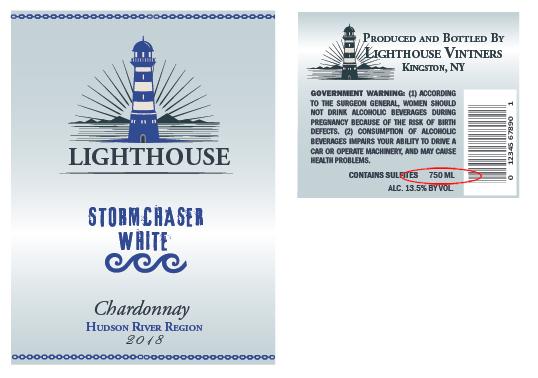The net contents statement indicates how much wine is in the container on which the label appears.

On the label above, “750 mL” is the net contents. In this example, it is located on the back label.
Where should the net contents statement be placed on the product?
The net contents may appear on the front, back, or side of the container.
The net contents may be blown or branded into the bottle in lieu of or in addition to stating net contents on the label.
What are the formatting requirements for the net contents statement?
- The net contents of wine for which a “standard of fill” is prescribed in 27 CFR 4.72 must be stated in the same manner and form as set forth in the standard of fill.
- The net contents of wine for which no standard of fill is prescribed in 27 CFR 4.72 must be stated in the metric system of measure.
Type size:
- Minimum 2 mm for containers larger than 187 mL,
- Minimum 1 mm for containers of 187 mL or less.
Note: The minimum type size applies to each numeral or letter in the statement, including both upper-case and lower-case letters.
Legibility:
- Must be readily legible under ordinary conditions;
- Must appear on a contrasting background; and
- Must appear separate and apart from, or be substantially more conspicuous than, descriptive or explanatory information.
Does the net contents statement need to indicate the contents of the container exactly, or does TTB allow a tolerance?
Statements of net contents must indicate exactly the volume of wine within the container, with limited tolerances provided in 27 CFR 4.37(d).
Unreasonable shortages in some containers in a shipment may not be compensated by overages in other containers in the same shipment.
For tolerance requirements for products removed from wine premises, please see 27 CFR 24.255.
What requirements apply to standard wine containers?
- Design: A standard wine container must be made and formed in a manner that will not mislead the purchaser. Wine containers will be considered misleading (even if the correct net contents appear on the label) if the actual capacity is substantially less than the apparent capacity upon visual examination under ordinary conditions of purchase or use.
- Headspace: A standard wine container must be made and filled so that it has a headspace not in excess of 6 percent of its total capacity after closure if the net content of the container is 187 mL or more, and a headspace not in excess of 10 percent of its total capacity in the case of all other containers.
- Fill: A standard wine container must contain the quantity of wine specified in one of the standards of fill.
What are the authorized standards of fill?
The authorized standards of fill are:
| 3 Liters | 355 mL |
| 1.5 Liters | 250 mL |
| 1 Liter | 200 mL |
| 750 mL | 187 mL |
| 500 mL | 100 mL |
| 375 mL | 50 mL |
For wine bottled or packed in containers of 4 - 17 liters, the net contents must be expressed in even liters (e.g., 4 liters, 5 liters, 6 liters, etc.).
What products are exempted from the standard wine container and standards of fill requirements?
The regulations requiring standard wine containers and standards of fill do not apply to:
What are the net contents statement requirements for saké?
For saké that is not bottled or packed in containers that meet the standard of fill requirements, the net contents must be expressed:
- In liters and decimal portions of a liter accurate to the nearest one-hundredth of a liter for containers of one liter or more (e.g., 1 liter, 3.75 liters, etc.).
- In milliliters for containers of less than one liter.
What are the net contents requirements for wine packed in containers of 18 liters or more?
For wine bottled or packed in containers of 18 liters or more, the net contents must be expressed in liters and decimal portions of a liter accurate to the nearest one-hundredth of a liter.
May I use U.S. equivalent measurements in addition to a metric net contents statement?
Yes, the U.S. equivalent stated in fluid ounces for the metric size may also be shown on the label.
The established U.S. equivalents for the metric standards of fill are as follows:
| 3 Liters (101 fl. oz.) | 355 mL (12 fl. oz.) |
| 1.5 Liters (50.7 fl. oz.) | 250 mL (8.5 fl. oz.) |
| 1 Liter (33.8 fl. oz.) | 200 mL (6.8 fl. oz.) |
| 750 mL (25.4 fl. oz.) | 187 mL (6.3 fl. oz.) |
| 500 mL (16.9 fl. oz.) | 100 mL (3.4 fl. oz.) |
| 375 mL (12.7 fl. oz.) | 50 mL (1.7 fl. oz.) |
Equivalents for other metric sizes must be:
- Accurate to the nearest one-tenth of a fluid ounce for equivalents of less than 100 fluid ounces.
- Accurate to the nearest whole fluid ounce for equivalents of 100 fluid ounces or more.

